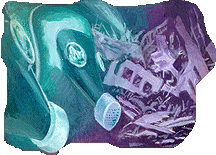| OOTW Home | Strange Worlds |
![]()
![]()
| OOTW Home | Strange Worlds |

Since World War II, one of the most prevalent themes of speculative fiction has been nuclear war. Many science fiction writers have explored the possible aftermath of a nuclear exchange or accident.
In his post-apocalypse trilogy, The Erthring Cycle, Wayland Drew writes about the tribes who inhabit what is left of Canada's west coast. Other depictions of a world after nuclear holocaust include Helene Holden's After the Fact, Hugh Hood's short story "After the Sirens" and Phyllis Gotlieb's Sunburst. Gotlieb's work describes how radiation creates mutant telepathic children.
In Heather Spears' Moonfall and The Children of Atwar, nuclear war has left humanity so genetically scarred that having two heads is the norm.
 The Gaian Expedient
The Gaian Expedient
Drew, Wayland
Toronto: Random House of Canada, 1985.
Civilization disappeared with the end of the twentieth century. A hidden colony on the remains of Canada's west coast survived for a few hundred years, but now, as recounted in the second book of the Ethring Cycle, it seems that the end is near once more.
 After the Fact
After the Fact
Holden, Hélène
Ottawa: Oberon Press, 1986.
What happens to a civilization after a major catastrophe when all accepted standards are questioned? How does one act in a society when all the rules have been broken? Just what happens After the Fact?
 Moonfall
Moonfall
Spears, Heather
Victoria, B.C.: Beach Holme Publishers, 1991.
In this post-holocaust culture populated by twins sharing the same body, Tasman is alone. And alone, she must begin her quest to save the earth.
Used by permission of Beach Holme Publishers, Victoria, B.C.
| Top of page |
|---|